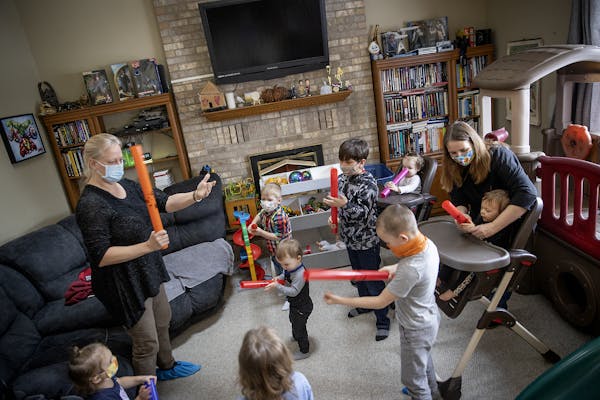Carla Green spends about six hours a day on her computer, studying for her GED, selling custom scents and doing other work.
Green, 26, has been struggling to pay $60 a month for wired internet service in her International Falls apartment — something she needs to make a better life, she says.
So she reached out to a local community action program for help and is waiting to get a provided hot spot, which she hopes will be fast and reliable enough for her school work.
Recognizing the millions of households in Green's situation, Congress designated emergency help for families to acquire and keep internet service in the latest federal COVID-19 relief package.
The $900 billion stimulus includes $7 billion for broadband and network infrastructure initiatives, including $3.2 billion for emergency help with monthly bills for service. Rural areas, tribal governments and other underserved populations will benefit as well.
"It's super important," said Angela Siefer, executive director of the National Digital Inclusion Alliance, which advocates for connectivity. "The census tells us 36 million U.S. households do not have a broadband (wire line) connection in their home; 26 million are urban … that's not an availability problem, that's an affordability and digital literacy problem."
In the stimulus package, about $3.2 billion is slated to help financially struggling households with up to $50 a month for internet service (or $75 per month for those on tribal lands) with payments going directly to the service providers. Those eligible could include households with children on free and reduced school lunches, Pell Grant recipients or the recently unemployed, according to an analysis by the alliance.
The Federal Communications Commission, which is tasked with figuring out how to administer the program, is taking public comment through Feb. 16.
In Itasca County, 21% of households do not have internet access — not even through a cellphone, said Isaac Meyer, planning and development director for KOOTASCA Community Action, a nonprofit in Itasca and Koochiching counties that helps connect residents in poverty to government programs and other help.
While geography and other factors prevent clients from getting access to the web, "I would say the vast majority of that is income," Meyer said. "People aren't purchasing an essential utility not because they don't want it,[but] because they can't afford it … heat, water, rent tend to come first, long before internet."
As more business has gone online during the pandemic, it has widened the divide between those who have internet and those who don't, he said, prompting those without internet to pay bills and make purchases in person.
"How can you limit your exposure to the coronavirus when you have to go everywhere for everything?" Meyer said.
Perhaps most importantly, the pandemic made internet access even more of a necessity for school and work, too, when millions of students and employees were sent home for distance learning and working.
More than 70% of workers who say they can work from home were doing so, according to an October survey by the Pew Research Center.
The stimulus package also includes $1.9 billion to replace unsecure communications equipment to prevent hacking, $1 billion for connecting underserved tribal lands, and $285 million to better connect minority-serving institutions such as tribal and historically Black colleges and universities.
In addition, $300 million will go to expand broadband in rural areas. In Minnesota, about 17% of rural homes do not have wire line internet service with download speeds of at least 25 megabits per second, and are considered "unserved."
About $65 million will go to improve the accuracy of broadband availability maps — one of several measures U.S. Sen. Amy Klobuchar, D-Minn., has advocated as co-chair of the Senate Broadband Caucus.
"Every family in America should have access to high-speed internet, regardless of their ZIP code," Klobuchar said in a statement. "The pandemic has exposed how critical broadband is to staying connected to work, school, health care and more."
Better maps may help people such as Kathy Moore and her husband, whose three teenage children are distance learning using a combination of Wi-Fi at a local Wendy's parking lot and hot spots in their home in Lake Shore, in the Brainerd Lakes area. Though maps show their house is covered, she said, they would have to pay $15,000 to bring cable to their home — a service she believes wouldn't be fast or reliable anyway because they would be at the end of the line.
Though they acknowledge that they are choosing to live in the woods and that internet providers put lines in where it makes the best business sense, they are not far from civilization and can sometimes even hear music from local resorts, she said.
"It's just like putting up electricity. At some point, our government said 'we're gonna do it,' " Moore said. "Why isn't broadband that same way?"
Minnesota officials overseeing state broadband efforts aren't sure how the federal stimulus package will be administered but said they are eager to find out.
"As the new administration gets up and running the next few months, I imagine they'll move quickly," said Angie Dickison, broadband development manager for the Minnesota Department of Employment and Economic Development. "We're looking forward to hearing more about these programs, for sure."
Pam Louwagie • 612-673-7102

Want to share info with the Star Tribune? How to do it securely

'Safe recovery sites' would offer syringes, naloxone and more to people using drugs. The plan could be in peril.
New Minnesota GOP leaders seek peace with party's anti-establishment wing

Who is Republican Lisa Demuth, Minnesota's first House speaker of color?

